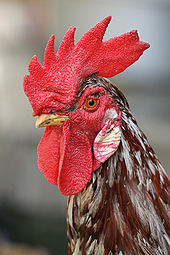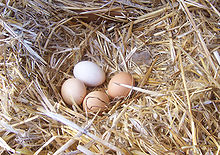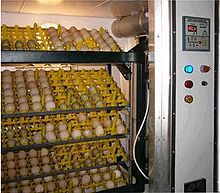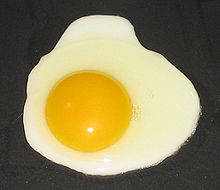- Chicken
-
"Gallus gallus domesticus" redirects here. For other subspecies, see Red Junglefowl."Chooks" redirects here. For the fast food chain, see Chooks Fresh & Tasty.This article is about the animal. For chicken as human food, see Chicken (food). For other uses, see Chicken (disambiguation).
Chicken 
A rooster (left) and hen (right) Conservation status DomesticatedScientific classification Kingdom: Animalia Phylum: Chordata Class: Aves Order: Galliformes Family: Phasianidae Subfamily: Phasianinae Genus: Gallus Species: Gallus gallus Subspecies: Gallus gallus domesticus
(Linnaeus, 1758)Synonyms The chicken (Gallus gallus domesticus) is a domesticated fowl, a subspecies of the Red Junglefowl. As one of the most common and widespread domestic animals, and with a population of more than 24 billion in 2003,[1] there are more chickens in the world than any other species of bird. Humans keep chickens primarily as a source of food, consuming both their meat and their eggs.
The traditional poultry farming view of the domestication of the chicken is stated in Encyclopaedia Britannica (2007): "Humans first domesticated chickens of Indian origin for the purpose of cockfighting in Asia, Africa, and Europe. Very little formal attention was given to egg or meat production... "[2] Recent genetic studies have pointed to multiple maternal origins in Southeast, East, and South Asia, but with the clade found in the Americas, Europe, the Middle East and Africa originating in the Indian subcontinent. From India the domesticated fowl made its way to the Persianized kingdom of Lydia in western Asia Minor, and domestic fowl were imported to Greece by the fifth century BC.[3] Fowl had been known in Egypt since the 18th Dynasty, with the "bird that lays every day" having come to Egypt from the land between Syria and Shinar, Babylonia, according to the annals of Tutmose III.[4]
Terminology
In the UK, Ireland and Australia adult male chickens over the age of 12 months are primarily known as cocks, whereas in America and Canada they are more commonly called roosters. Males under a year old are cockerels.[5] Castrated roosters are called capons (surgical and chemical castration are now illegal in some parts of the world). Females over a year old are known as hens, and younger females are pullets.[6] In Australia and New Zealand (also sometimes in Britain), there is a generic term chook (
 /ˈtʃʊk/) to describe all ages and both sexes.[7] Babies are called chicks, and the meat is called chicken.
/ˈtʃʊk/) to describe all ages and both sexes.[7] Babies are called chicks, and the meat is called chicken."Chicken" originally referred to chicks, not the species itself. The species as a whole was then called domestic fowl, or just fowl. This use of "chicken" survives in the phrase "Hen and Chickens", sometimes used as a British public house or theatre name, and to name groups of one large and many small rocks or islands in the sea (see for example Hen and Chicken Islands).
In the Deep South of the United States chickens are also referred to by the slang term yardbird.[8]
General biology and habitat
Chickens are omnivores.[9] In the wild, they often scratch at the soil to search for seeds, insects and even larger animals such as lizards or young mice.[10]
Chickens may live for five to ten years, depending on the breed.[11] The world's oldest chicken, a hen, died of heart failure at the age of 16 according to the Guinness Book of World Records.[12]
Roosters can usually be differentiated from hens by their striking plumage of long flowing tails and shiny, pointed feathers on their necks (hackles) and backs (saddle) which are typically of brighter, bolder colors than those of females of the same species. However, in some breeds, such as the Sebright, the rooster has only slightly pointed neck feathers, the same color as the hen's. The identification must be made by looking at the comb, or eventually from the development of spurs on the male's legs (in a few breeds and in certain hybrids the male and female chicks may be differentiated by color). Adult chickens have a fleshy crest on their heads called a comb or cockscomb, and hanging flaps of skin either side under their beaks called wattles. Both the adult male and female have wattles and combs, but in most breeds these are more prominent in males. A muff or beard is a mutation found in several chicken breeds which causes extra feathering under the chicken's face, giving the appearance of a beard.
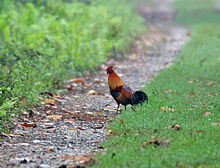 Wild Red Junglefowl
Wild Red Junglefowl
Domestic chickens are not capable of long distance flight, although lighter birds are generally capable of flying for short distances, such as over fences or into trees (where they would naturally roost). Chickens may occasionally fly briefly to explore their surroundings, but generally do so only to flee perceived danger.
Chickens are gregarious birds and live together in flocks. They have a communal approach to the incubation of eggs and raising of young. Individual chickens in a flock will dominate others, establishing a "pecking order", with dominant individuals having priority for food access and nesting locations. Removing hens or roosters from a flock causes a temporary disruption to this social order until a new pecking order is established. Adding hens—especially younger birds—to an existing flock can lead to violence and injury.[13]
Hens will try to lay in nests that already contain eggs, and have been known to move eggs from neighboring nests into their own. Some farmers use fake eggs made from plastic or stone (or golf balls) to encourage hens to lay in a particular location. The result of this behavior is that a flock will use only a few preferred locations, rather than having a different nest for every bird.
Hens can also be extremely stubborn about always laying in the same location. It is not unknown for two (or more) hens to try to share the same nest at the same time. If the nest is small, or one of the hens is particularly determined, this may result in chickens trying to lay on top of each other.
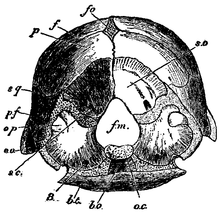 Skull of a chicken three weeks old. Here the opisthotic bone appears in the occipital region, as in the adult Chelonian. bo = Basi-occipital, bt = Basi-temporal, eo = Opisthotic, f = Frontal, fm = Foramen magnum, fo = Fontanella, oc = Occipital condyle, op = Opisthotic, p = Parietal, pf = Post-frontal, sc = Sinus canal in supra-occipital, so = Supra-occpital, sq = Squamosal, 8 = Exit of vagus nerve.
Skull of a chicken three weeks old. Here the opisthotic bone appears in the occipital region, as in the adult Chelonian. bo = Basi-occipital, bt = Basi-temporal, eo = Opisthotic, f = Frontal, fm = Foramen magnum, fo = Fontanella, oc = Occipital condyle, op = Opisthotic, p = Parietal, pf = Post-frontal, sc = Sinus canal in supra-occipital, so = Supra-occpital, sq = Squamosal, 8 = Exit of vagus nerve.
Roosters crowing (a loud and sometimes shrill call) is a territorial signal to other roosters. However, crowing may also result from sudden disturbances within their surroundings. Hens cluck loudly after laying an egg, and also to call their chicks. Chickens also give a low "warning call" when they think they see a predator approaching.
In 2006, scientists researching the ancestry of birds "turned on" a chicken recessive gene, talpid2, and found that the embryo jaws initiated formation of teeth, like those found in ancient bird fossils. John Fallon, the overseer of the project, stated that chickens have "...retained the ability to make teeth, under certain conditions... ."[14]
Food sharing and courting
When a rooster finds food, he may call other chickens to eat first. He does this by clucking in a high pitch as well as picking up and dropping the food. This behavior may also be observed in mother hens to call their chicks and encourage them to eat.
To initiate courting, some roosters may dance in a circle around or near a hen ("a circle dance"), often lowering his wing which is closest to the hen.[15] The dance triggers a response in the hen's brain,[15] and when the hen responds to his "call", the rooster may mount the hen and proceed with the fertilization.
Breeding
Origins
The domestic chicken is descended primarily from the Red Junglefowl (Gallus gallus) and is scientifically classified as the same species.[16] As such it can and does freely interbreed with populations of red jungle fowl.[16] Recent genetic analysis has revealed that at least the gene for yellow skin was incorporated into domestic birds through hybridization with the Grey Junglefowl (G. sonneratii).[17] The traditional poultry farming view is stated in Encyclopaedia Britannica (2007): "Humans first domesticated chickens of Indian origin for the purpose of cockfighting in Asia, Africa, and Europe. Very little formal attention was given to egg or meat production... "[18] In the last decade there have been a number of genetic studies. According to one study, a single domestication event occurring in the region of modern Thailand created the modern chicken with minor transitions separating the modern breeds.[19] However, that study was later found to be based on incomplete data, and recent studies point to multiple maternal origins, with the clade found in the Americas, Europe, Middle East, and Africa, originating from the Indian subcontinent, where a large number of unique haplotypes occur.[20][21]
It has been claimed (based on paleoclimatic assumptions) that chickens were domesticated in Southern China in 6000 BC.[22] However, according to a recent study,[23] "it is not known whether these birds made much contribution to the modern domestic fowl. Chickens from the Harappan culture of the Indus Valley (2500-2100 BC), in what today is Pakistan, may have been the main source of diffusion throughout the world."
A northern road spread chicken to the Tarim basin of central Asia. The chicken reached Europe (Romania, Turkey, Greece, Ukraine) about 3000 BC.[24] Introduction into Western Europe came far later, about the 1st millennium BC. Phoenicians spread chickens along the Mediterranean coasts, to Iberia. Breeding increased under the Roman Empire, and was reduced in the Middle Ages.[24] Middle East traces of chicken go back to a little earlier than 2000 BC, in Syria; chicken went southward only in the 1st millennium BC. The chicken reached Egypt for purposes of cock fighting about 1400 BC, and became widely bred only in Ptolemaic Egypt (about 300 BC).[24] Little is known about the chicken's introduction into Africa. Three possible ways of introduction in about the early first millennium AD could have been through the Egyptian Nile Valley, the East Africa Roman-Greek or Indian trade, or from Carthage and the Berbers, across the Sahara. The earliest known remains are from Mali, Nubia, East Coast, and South Africa and date back to the middle of the first millennium AD.[24] Domestic chicken in the Americas before Western conquest is still an ongoing discussion, but blue-egged chicken, found only in the Americas and Asia, suggest an Asian origin for early American chickens.[24]
A lack of data from Thailand, Russia, the Indian subcontinent, Southeast Asia and Sub-Saharan Africa makes it difficult to lay out a clear map of the spread of chickens in these areas; better description and genetic analysis of local breeds threatened by extinction may also help with research into this area.[24]
Current
Earliest gestation stages and blood circulation of a chicken embryo
Under natural conditions, most birds lay only until a clutch is complete, and they will then incubate all the eggs. Many domestic hens will also do this–and are then said to "go broody". The broody hen will stop laying and instead will focus on the incubation of the eggs (a full clutch is usually about 12 eggs). She will "sit" or "set" on the nest, protesting or pecking in defense if disturbed or removed, and she will rarely leave the nest to eat, drink, or dust-bathe. While brooding, the hen maintains the nest at a constant temperature and humidity, as well as turning the eggs regularly during the first part of the incubation. To stimulate broodiness, an owner may place many artificial eggs in the nest, or to stop it they may place the hen in an elevated cage with an open wire floor.
At the end of the incubation period (about 21 days),[15] the eggs, if fertile, will hatch. Development of the egg starts only when incubation begins, so they all hatch within a day or two of each other, despite perhaps being laid over a period of two weeks or so. Before hatching, the hen can hear the chicks peeping inside the eggs, and will gently cluck to stimulate them to break out of their shells. The chick begins by "pipping"; pecking a breathing hole with its egg tooth towards the blunt end of the egg, usually on the upper side. The chick will then rest for some hours, absorbing the remaining egg yolk and withdrawing the blood supply from the membrane beneath the shell (used earlier for breathing through the shell). It then enlarges the hole, gradually turning round as it goes, and eventually severing the blunt end of the shell completely to make a lid. It crawls out of the remaining shell, and its wet down dries out in the warmth of the nest.
The hen will usually stay on the nest for about two days after the first egg hatches, and during this time the newly hatched chicks live off the egg yolk they absorb just before hatching. Any eggs not fertilized by a rooster will not hatch, and the hen eventually loses interest in these and leaves the nest. After hatching, the hen fiercely guards the chicks, and will brood them when necessary to keep them warm, at first often returning to the nest at night. She leads them to food and water; she will call them to edible items, but seldom feeds them directly. She continues to care for them until they are several weeks old, when she will gradually lose interest and eventually start to lay again.
Modern egg-laying breeds rarely go broody, and those that do often stop part-way through the incubation. However, some "utility" (general purpose) breeds, such as the Cochin, Cornish and Silkie, do regularly go broody, and they make excellent mothers, not only for chicken eggs but also for those of other species—even those with much smaller or larger eggs and different incubation periods, such as quail, pheasants, turkeys or geese. Chicken eggs can also be hatched under a broody duck, with varied success.
Poultry farming
Main article: Poultry farming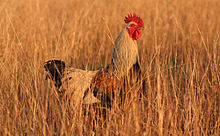 A free range rooster on a farm
A free range rooster on a farm
More than 50 billion chickens are reared annually as a source of food, for both their meat and their eggs.
The vast majority of poultry are raised using intensive farming techniques. According to the Worldwatch Institute, 74 percent of the world's poultry meat, and 68 percent of eggs are produced this way. One alternative to intensive poultry farming is free range farming.
Friction between these two main methods has led to long term issues of ethical consumerism. Opponents of intensive farming argue that it harms the environment, creates human health risks and is inhumane. Advocates of intensive farming say that their highly efficient systems save land and food resources due to increased productivity, stating that the animals are looked after in state-of-the-art environmentally controlled facilities.
In part due to the conditions on intensive poultry farms and recent recalls of large quantities of eggs, there is a growing movement for small scale micro-flocks or 'backyard chickens'. This involves keeping small numbers of hens (usually no more than a dozen), in suburban or urban residential areas to control bugs, utilize chicken waste as fertilizer in small gardens, and of course for the high-quality eggs and meat that are produced.
Chickens reared for meat
Main article: BroilerChickens farmed for meat are called broiler chickens. Chickens will naturally live for 6 or more years, but broiler chickens typically take less than 6 weeks to reach slaughter size.[25] A free range or organic meat chicken will usually be slaughtered at about 14 weeks of age.
Chickens reared for eggs
Chickens farmed for eggs are called egg-laying hens. In total, the UK alone consumes over 29 million eggs per day. Some hen breeds can produce over 300 eggs per year. After 12 months of laying, the commercial hen's egg-laying ability starts to decline to the point where the flock is unviable. Hens, particularly from battery cage systems, are sometimes infirm, have lost a significant amount of their feathers, and their life expectancy has been reduced from around 7 years to less than 2 years.[26] In the UK and Europe, laying hens are then slaughtered and used in processed foods, or sold as "soup hens".[27] In some other countries, flocks are sometimes force moulted, rather than being slaughtered, to reinvigorate egg-laying. This involves complete withdrawal of food (and sometimes water) for 7-14 days[28] or sufficiently long to cause a body weight loss of 25 to 35%,[29] or up to 28 days under experimental conditions[30] which presumably reflect farming practice. This stimulates the hen to lose her feathers, but also reinvigorates egg-production. Some flocks may be force moulted several times. In 2003, more than 75% of all flocks were moulted in the US.[31]
Artificial incubation
Incubation can successfully occur artificially in machines that provide the correct, controlled environment for the developing chick.[32][33][34][35] The average incubation period for chickens is 21 days but may depend on the temperature and humidity in the incubator. Temperature regulation is the most critical factor for a successful hatch. Variations of more than 1 °F (1.8 °C) from the optimum temperature of 99.5 °F (37.5 °C) will reduce hatch rates. Humidity is also important because the rate at which eggs lose water by evaporation depends on the ambient relative humidity. Evaporation can be assessed by candling, to view the size of the air sac, or by measuring weight loss. Relative humidity should be increased to around 70% in the last three days of incubation to keep the membrane around the hatching chick from drying out after the chick cracks the shell. Lower humidity is usual in the first 18 days to ensure adequate evaporation. The position of the eggs in the incubator can also influence hatch rates. For best results, eggs should be placed with the pointed ends down and turned regularly (at least three times per day) until one to three days before hatching. If the eggs aren't turned, the embryo inside may stick to the shell and may hatch with physical defects. Adequate ventilation is necessary to provide the embryo with oxygen. Older eggs require increased ventilation.
Many commercial incubators are industrial-sized with shelves holding tens of thousands of eggs at a time, with rotation of the eggs a fully automated process. Home incubators are boxes holding from half a dozen to 75 eggs; they are usually electrically powered, but in the past some were heated with an oil or paraffin lamp.
Chicken eggs as food
Main articles: Egg (food) and List of egg dishesChicken eggs are widely used in many types of dishes, both sweet and savory, including many baked goods. Eggs can be scrambled, fried, hard-boiled, soft-boiled, pickled, and poached. The albumen, or egg white, contains protein but little or no fat, and can be used in cooking separately from the yolk. Egg whites may be aerated or whipped to a light, fluffy consistency and are often used in desserts such as meringues and mousse. Ground egg shells are sometimes used as a food additive to deliver calcium. Some people prefer to just have a female, and raise it for the eggs.
Chickens as food
Main article: Chicken (food)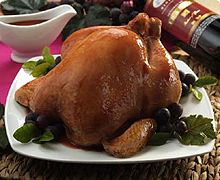 Roasted chicken.
Roasted chicken.
The meat of the chicken, also called "chicken", is a type of poultry meat. Because of its relatively low cost, chicken is one of the most used meats in the world. Nearly all parts of the bird can be used for food, and the meat can be cooked in many different ways. Popular chicken dishes include roasted chicken, fried chicken, chicken soup, Buffalo wings, tandoori chicken, butter chicken, and chicken rice. Chicken is also a staple of many fast food restaurants.
Chickens as pets
Main article: Chickens as petsChickens are sometimes kept as pets and can be tamed by hand feeding, but roosters can sometimes become aggressive and noisy, although aggression can be curbed with proper handling. Some have advised against keeping them around very young children. Certain breeds, however, such as silkies and many bantam varieties are generally docile and are often recommended as good pets around children with disabilities.[36] Some people find chickens' behaviour entertaining and educational.[37]
Chicken diseases and ailments
Chickens are susceptible to several parasites, including lice, mites, ticks, fleas, and intestinal worms, as well as other diseases. Despite the name, they are not affected by chickenpox, which is generally restricted to humans.[38]
Some of the common diseases that affect chickens are shown below:
Name Common Name Caused by Aspergillosis fungi Avian influenza bird flu virus Histomoniasis Blackhead disease protozoal parasite Botulism toxin Cage Layer Fatigue mineral deficiencies, lack of exercise Campylobacteriosis tissue injury in the gut Coccidiosis parasites Colds virus Crop Bound improper feeding Dermanyssus gallinae Red mite parasite Egg bound oversized egg Erysipelas bacteria Fatty Liver Hemorrhagic Syndrome high-energy food Fowl Cholera bacteria Fowl pox virus Fowl Typhoid bacteria Gallid herpesvirus 1
or Infectious Laryngotracheitisvirus Gapeworm Syngamus trachea worms Infectious Bronchitis virus Infectious Bursal Disease Gumboro virus Infectious Coryza bacteria Lymphoid leukosis Avian leukosis virus Marek's disease virus Moniliasis Yeast Infection
or Thrushfungi Mycoplasmas bacteria-like organisms Newcastle disease virus Necrotic Enteritis bacteria Omphalitis Mushy chick disease umbilical cord stump Peritonitis[39] Infection in abdomen from egg yolk Prolapse Psittacosis bacteria Pullorum Salmonella bacteria Scaly leg parasites Squamous cell carcinoma cancer Tibial dyschondroplasia speed growing Toxoplasmosis protozoal parasite Ulcerative Enteritis bacteria Ulcerative pododermatitis Bumblefoot bacteria Chickens in religion and mythology
In Indonesia the chicken has great significance during the Hindu cremation ceremony. A chicken is considered a channel for evil spirits which may be present during the ceremony. A chicken is tethered by the leg and kept present at the ceremony for its duration to ensure that any evil spirits present during the ceremony go into the chicken and not the family members present. The chicken is then taken home and returns to its normal life.
In ancient Greece, the chicken was not normally used for sacrifices, perhaps because it was still considered an exotic animal. Because of its valor, the cock is found as an attribute of Ares, Heracles, and Athena. The alleged last words of Socrates as he died from hemlock poisoning, as recounted by Plato, were "Crito, I owe a cock to Asclepius; will you remember to pay the debt?", signifying that death was a cure for the illness of life.
The Greeks believed that even lions were afraid of cocks. Several of Aesop's Fables reference this belief.
In the New Testament, Jesus prophesied the betrayal by Peter: "Jesus answered, 'I tell you, Peter, before the rooster crows today, you will deny three times that you know me.'" (Luke 22:34) Thus it happened (Luke 22:61), and Peter cried bitterly. This made the cock a symbol for both vigilance and betrayal.
Earlier, Jesus compares himself to a mother hen when talking about Jerusalem: "O Jerusalem, Jerusalem, you who kill the prophets and stone those sent to you, how often I have longed to gather your children together, as a hen gathers her chicks under her wings, but you were not willing." (Matthew 23:37; also Luke 13:34).
In many Central European folk tales, the devil is believed to flee at the first crowing of a cock.
In traditional Jewish practice, a kosher animal is swung around the head and then slaughtered on the afternoon before Yom Kippur, the Day of Atonement, in a ritual called kapparos. A chicken or fish is typically used because it is commonly available (and small enough to hold). The sacrifice of the animal is to receive atonement, for the animal symbolically takes on all the person's sins in kapparos. The meat is then donated to the poor. A woman brings a hen for the ceremony, while a man brings a rooster. Although not actually a sacrifice in the biblical sense, the death of the animal reminds the penitent sinner that his or her life is in God's hands.
The Talmud speaks of learning "courtesy toward one's mate" from the rooster (Eruvin 100b). This might refer to the fact that when a rooster finds something good to eat, he calls his hens to eat first.
The chicken is one of the Zodiac symbols of the Chinese calendar. Also in Chinese religion, a cooked chicken as a religious offering is usually limited to ancestor veneration and worship of village deities. Vegetarian deities such as the Buddha are not one of the recipients of such offerings. Under some observations, an offering of chicken is presented with "serious" prayer (while roasted pork is offered during a joyous celebration). In Confucian Chinese Weddings, a chicken can be used as a substitute for one who is seriously ill or not available (e.g. sudden death) to attend the ceremony. A red silk scarf is placed on the chicken's head and a close relative of the absent bride/groom holds the chicken so the ceremony may proceed. However, this practice is rare today.
A cockatrice was supposed to have been born from an egg laid by a rooster, as well as killed by a Rooster's call.
Chickens in history
 The Red Junglefowl
The Red Junglefowl
An early domestication of chickens in Southeast Asia is probable, since the word for domestic chicken (*manuk) is part of the reconstructed Proto-Austronesian language (see Austronesian languages). Chickens, together with dogs and pigs, were the domestic animals of the Lapita culture, the first Neolithic culture of Oceania.
The first pictures of chickens in Europe are found on Corinthian pottery of the 7th century BC. The poet Cratinus (mid-5th century BC, according to the later Greek author Athenaeus) calls the chicken "the Persian alarm". In Aristophanes's comedy The Birds (414 BC) a chicken is called "the Median bird", which points to an introduction from the East. Pictures of chickens are found on Greek red figure and black-figure pottery.
In ancient Greece, chickens were still rare and were a rather prestigious food for symposia. Delos seems to have been a center of chicken breeding.
The Romans used chickens for oracles, both when flying ("ex avibus", Augury) and when feeding ("auspicium ex tripudiis", Alectryomancy). The hen ("gallina") gave a favourable omen ("auspicium ratum"), when appearing from the left (Cic.,de Div. ii.26), like the crow and the owl.
For the oracle "ex tripudiis" according to Cicero (Cic. de Div. ii.34), any bird could be used, but normally only chickens ("pulli") were consulted. The chickens were cared for by the pullarius, who opened their cage and fed them pulses or a special kind of soft cake when an augury was needed. If the chickens stayed in their cage, made noises ("occinerent"), beat their wings or flew away, the omen was bad; if they ate greedily, the omen was good.
In 249 BC, the Roman general Publius Claudius Pulcher had his chickens thrown overboard when they refused to feed before the battle of Drepana, saying "If they won't eat, perhaps they will drink." He promptly lost the battle against the Carthaginians and 93 Roman ships were sunk. Back in Rome, he was tried for impiety and heavily fined.
In 161 BC, a law was passed in Rome that forbade the consumption of fattened chickens. It was renewed a number of times, but does not seem to have been successful. Fattening chickens with bread soaked in milk was thought to give especially delicious results. The Roman gourmet Apicius offers 17 recipes for chicken, mainly boiled chicken with a sauce. All parts of the animal are used: the recipes include the stomach, liver, testicles and even the pygostyle (the fatty "tail" of the chicken where the tail feathers attach).
The Roman author Columella gives advice on chicken breeding in his eighth book of his treatise on agriculture. He identifies Tanagrian, Rhodic, Chalkidic and Median (commonly misidentified as Melian) breeds, which have an impressive appearance, a quarrelsome nature and were used for cockfighting by the Greeks. For farming, native (Roman) chickens are to be preferred, or a cross between native hens and Greek cocks. Dwarf chickens are nice to watch because of their size but have no other advantages.
Per Columella, the ideal flock consists of 200 birds, which can be supervised by one person if someone is watching for stray animals. White chickens should be avoided as they are not very fertile and are easily caught by eagles or goshawks. One cock should be kept for five hens. In the case of Rhodian and Median cocks that are very heavy and therefore not much inclined to sex, only three hens are kept per cock. The hens of heavy fowls are not much inclined to brood; therefore their eggs are best hatched by normal hens. A hen can hatch no more than 15-23 eggs, depending on the time of year, and supervise no more than 30 hatchlings. Eggs that are long and pointed give more male, rounded eggs mainly female hatchlings.
Per Columella, chicken coops should face southeast and lie adjacent to the kitchen, as smoke is beneficial for the animals. Coops should consist of three rooms and possess a hearth. Dry dust or ash should be provided for dust-baths.
According to Columella, chicken should be fed on barley groats, small chick-peas, millet and wheat bran, if they are cheap. Wheat itself should be avoided as it is harmful to the birds. Boiled ryegrass (Lollium sp.) and the leaves and seeds of alfalfa (Medicago sativa L.) can be used as well. Grape marc can be used, but only when the hens stop laying eggs, that is, about the middle of November; otherwise eggs are small and few. When feeding grape marc, it should be supplemented with some bran. Hens start to lay eggs after the winter solstice, in warm places around the first of January, in colder areas in the middle of February. Parboiled barley increases their fertility; this should be mixed with alfalfa leaves and seeds, or vetches or millet if alfalfa is not at hand. Free-ranging chickens should receive two cups of barley daily.
Columella advises farmers to slaughter hens that are older than three years, because they no longer produce sufficient eggs.
Capons were produced by burning out their spurs with a hot iron. The wound was treated with potter's chalk.
For the use of poultry and eggs in the kitchens of ancient Rome see Roman eating and drinking.
Chickens were spread by Polynesian seafarers and reached Easter Island in the 12th century AD, where they were the only domestic animal, with the possible exception of the Polynesian Rat (Rattus exulans). They were housed in extremely solid chicken coops built from stone.
Chickens in South America
An unusual variety of chicken that has its origins in South America is the araucana, bred in southern Chile by Mapuche people. Araucanas, some of which are tailless and some of which have tufts of feathers around their ears, lay blue-green eggs. It has long been suggested that they predate the arrival of European chickens brought by the Spanish and are evidence of pre-Columbian trans-Pacific contacts between Asian or Pacific Oceanic peoples, particularly the Polynesians and South America. In 2007, an international team of researchers reported the results of analysis of chicken bones found on the Arauco Peninsula in south central Chile. Radiocarbon dating suggested that the chickens were Pre-Columbian, and DNA analysis showed that they were related to prehistoric populations of chickens in Polynesia.[40] These results appeared to confirm that the chickens came from Polynesia and that there were transpacific contacts between Polynesia and South America before Columbus's arrival in the Americas.[41]
However, a later report looking at the same specimens concluded:
A published, apparently pre-Columbian, Chilean specimen and six pre-European Polynesian specimens also cluster with the same European/Indian subcontinental/Southeast Asian sequences, providing no support for a Polynesian introduction of chickens to South America. In contrast, sequences from two archaeological sites on Easter Island group with an uncommon haplogroup from Indonesia, Japan, and China and may represent a genetic signature of an early Polynesian dispersal. Modeling of the potential marine carbon contribution to the Chilean archaeological specimen casts further doubt on claims for pre-Columbian chickens, and definitive proof will require further analyses of ancient DNA sequences and radiocarbon and stable isotope data from archaeological excavations within both Chile and Polynesia.[42]
See also
- abnormal behaviour of birds in captivity
- Bantam (poultry)
- Chicken fat
- Chicken hypnotism
- Chicken or the egg
- Chickenpox
- Chook raffle - a type of raffle where the prize is a chicken.
- Feral chicken
- Gamebird hybrids - hybrids between chickens, peafowl, guineafowl and pheasants
- List of chicken breeds
- Rubber chicken
- Symbolic chickens
- Tastes like chicken
- "Why did the chicken cross the road?"
References
- ^ according to Firefly Encyclopedia of Birds, Ed. Perrins, Christopher. Buffalo, N.Y.: Firefly Books, Ltd., 2003.
- ^ Garrigus, W. P. (2007), "Poultry Farming". Encyclopædia Britannica.
- ^ Maguelonne Toussaint-Samat, (Anthea Bell, translator) The History of Food, Ch. 11 "The History of Poultry", revised ed. 2009, p. 306.
- ^ Howard Carter, "An Ostracon Depicting a Red Jungle-Fowl (The Earliest Known Drawing of the Domestic Cock)" The Journal of Egyptian Archaeology, 9.1/2 (April 1923), pp. 1-4.
- ^ "Cockerel - definitions from Dictionary.com". Dictionary.reference.com. http://dictionary.reference.com/browse/cockerel. Retrieved 2010-08-29.
- ^ "Pullet - definitions from Dictionary.com". Dictionary.reference.com. http://dictionary.reference.com/browse/pullet. Retrieved 2010-08-29.
- ^ "Definition of "chook" in Encarta. The vernacular use is said to be offensive in this dictionary but it may also be used as a term of jocular familiarity". Definition of "chook" in Encarta. The vernacular use is said to be offensive in this dictionary but it may also be used as a term of jocular familiarity. http://encarta.msn.com/dictionary_/chook.html.
- ^ Berhardt, Clyde E. B. (1986). I Remember: Eighty Years of Black Entertainment, Big Bands. Philadelphia: University of Pennsylvania Press. p. 153. ISBN 9780812280180. OCLC 12805260.
- ^ "Info on Chicken Care". ideas4pets. 2003. http://www.ideas-4-pets.com/pages-infopages/pages_id-24/index.html. Retrieved 2008-08-13.
- ^ Gerard P.Worrell AKA "Farmer Jerry". "Frequently asked questions about chickens & eggs". Ferry Landing Farm & Apiary. http://gworrell.freeyellow.com/chickenfaq.html. Retrieved 2008-08-13.
- ^ "The Poultry Guide - A to Z and FAQs". Ruleworks.co.uk. http://www.ruleworks.co.uk/cgi-bin/TUfaq.exe?Guide=Poultry&Category=Poultry%20-%20General#q9. Retrieved 2010-08-29.
- ^ Smith, Jamon. Tuscaloosanews.com "World’s oldest chicken starred in magic shows, was on 'Tonight Show’", Tuscaloosa News (Alabama, USA). 6 August 2006. Retrieved on 26 February 2008.
- ^ by Stonehead. "Introducing new hens to a flock « Musings from a Stonehead". Stonehead.wordpress.com. http://stonehead.wordpress.com/2006/06/28/introducing-new-hens-to-a-flock/. Retrieved 2010-08-29.
- ^ Scientists Find Chickens Retain Ancient Ability to Grow Teeth Ammu Kannampilly, ABC News, 2006-02-27. Retrieved 2007-10-01.
- ^ a b c Grandin, Temple; Johnson, Catherine (2005). [69-71 Animals in Translation]. New York, New York: Scribner. ISBN 0743247698. 69-71.
- ^ a b A genetic variation map for chicken with 2.8 million single-nucleotide polymorphisms. International Chicken Polymorphism Map Consortium (GK Wong et. al.) 2004. Nature 432, 717-722| doi:10.1038/nature03156
- ^ Eriksson J, Larson G, Gunnarsson U, Bed'hom B, Tixier-Boichard M, et al. (2008) Identification of the Yellow Skin Gene Reveals a Hybrid Origin of the Domestic Chicken. PLoS Genet January 23, 2008 Genetics.plosjournals.org
- ^ Garrigus, W. P. (2007), "Poultry Farming". Encyclopædia Britannica.
- ^ Fumihito, A; Miyake, T; Sumi, S; Takada, M; Ohno, S; Kondo, N (December 20, 1994), "One subspecies of the red junglefowl (Gallus gallus gallus) suffices as the matriarchic ancestor of all domestic breeds", PNAS 91 (26): 12505–12509
- ^ Liu, Yi-Ping; Wu, Gui-Sheng; Yao, Yong-Gang; Miao, Yong-Wang; Luikart, Gordon; Baig, Mumtaz; Beja-Pereira, Albano; Ding, Zhao-Li et al. (2006), "Multiple maternal origins of chickens: Out of the Asian jungles", Molecular Phylogenetics and Evolution 38 (1): 12–19
- ^ Zeder et al (2006) "Documenting domestication: the intersection of genetics and archaeology," Trends in Genetics, vol 22, number 3, pp. 139-155.
- ^ West, B., Zhou, B.X., 1988. "Did chickens go north? New evidence for domestication." J. Archaeol. Sci. 14, 515–533.
- ^ Al-Nasser, A. et al (June 2007) "Overview of chicken taxonomy and domestication.", World's Poultry Science Journal 63: 285-300.)
- ^ a b c d e f CHOF : The Cambridge History of Food, 2000, Cambridge University Press, vol.1, pp496-499
- ^ "Broiler Chickens Fact Sheet // Animals Australia". Animalsaustralia.org. http://www.animalsaustralia.org/factsheets/broiler_chickens.php. Retrieved 2010-08-29.
- ^ Browne, Anthony (2002-03-10). "Ten weeks to live". The Guardian (London). http://observer.guardian.co.uk/foodmonthly/story/0,,662799,00.html. Retrieved 2010-04-28.
- ^ Browne, Anthony (2002-03-10). "Ten weeks to live". The Guardian (London). http://observer.guardian.co.uk/foodmonthly/story/0,,662799,00.html. Retrieved 2010-04-28.
- ^ Patwardhan, D. and King, A., (2011). Review: feed withdrawal and non feed withdrawal moult. World's Poultry Science Journal, 67: 253-268
- ^ Webster, A.B., (2003). Physiology and behavior of the hen during induced moult. Poultry Science, 82: 992-1002
- ^ Molino, A.B., Garcia, E.A., Berto, D.A., Pelícia, K., Silva, A.P. and Vercese F., (2009). The Effects of Alternative Forced-Molting Methods on The Performance and Egg Quality of Commercial Layers. Brazilian Journal of Poultry Science, 11: 109-113
- ^ Yousaf, M. and Chaudhry, A.S., (2008). History, changing scenarios and future strategies to induce moulting in laying hens. World's Poultry Science Journal, 64: 65-75
- ^ Joe G. Berry. "Artificial Incubation". Oklahoma Cooperative Extension Service, Oklahoma State University. http://pods.dasnr.okstate.edu/docushare/dsweb/Get/Document-2104/ANSI-8100web.pdf. Retrieved 2010-09-29.
- ^ Phillip J. Clauer. "Incubating Eggs". Virginia Cooperative Extension Service, Virginia State University. http://pubs.ext.vt.edu/2902/2902-1090/2902-1090.pdf. Retrieved 2010-10-01.
- ^ "Incubation Handbook". Brinsea Products Ltd. http://www.brinsea.com/pdffiles/Brinsea_Handbook.pdf. Retrieved 2010-09-30.
- ^ "How To Hatch Chicken Eggs". www.backyardchickens.com. http://www.backyardchickens.com/LC-hatch.html. Retrieved 2010-09-30.
- ^ "Clucks and Chooks: A guide to keeping chickens". http://www.henkeeping.co.uk/which.html.
- ^ United Poultry Concerns. "Providing a Good Home for Chickens". http://www.upc-online.org/home.html. Retrieved 2009-05-04.
- ^ White TM, Gilden DH, Mahalingam R.. "An animal model of varicella virus infection". http://www.ncbi.nlm.nih.gov/pubmed/11556693. Retrieved 2009-05-01.
- ^ "Clucks and Chooks: guide to keeping chickens". http://www.henkeeping.co.uk.
- ^ DNA reveals how the chicken crossed the sea Brendan Borrell, Nature, 5 June 2007. Retrieved 2007-10-01.
- ^ A. A. Storey et al., "Radiocarbon and DNA evidence for a pre-Columbian introduction of Polynesian chickens to Chile", Proceedings of the National Academy of Sciences of the United States of America, www.pnas.org/cgi/doi/10.1073/pnas.0703993104; John Noble Wilford, "First Chickens in Americas were Brought from Polynesia, New York Times, June 5, 2007.
- ^ Indo-European and Asian origins for Chilean and Pacific chickens revealed by mtDNA. Jaime Gongora, Nicolas J. Rawlence, Victor A. Mobegi, Han Jianlin, Jose A. Alcalde, Jose T. Matus, Olivier Hanotte, Chris Moran, J. Austin, Sean Ulm, Atholl J. Anderson, Greger Larson and Alan Cooper, "Indo-European and Asian origins for Chilean and Pacific chickens revealed by mtDNA" PNAS July 29, 2008 vol. 105 no 30 Pnas.org
Further reading
- Green-Armytage, Stephen (October 2000). Extraordinary Chickens. Harry N. Abrams. ISBN 0810933438.
- Smith, Page; Charles Daniel (April 2000). The Chicken Book. University of Georgia Press. ISBN 082032213X.
External links
- Chickens at the Open Directory Project
Chicken As poultry Husbandry Chicken tractor • Free range • Yarding • Debeaking • Hatchery • Battery cage • Chick sexing • Chick culling • CandlingDishes Buffalo wings • Butter chicken • Chicken Kiev • Chicken soup • Coq au vin • Engagement Chicken • Fried chicken (Chicken fingers, Chicken nugget) • Hainanese chicken rice • Tandoori chickenReligion, mythology
and cultureDiseases Aspergillosis • Avian influenza • Avian sarcoma leukosis virus • Blackhead disease • Botulism • Campylobacteriosis • Candidiasis • Coccidiosis • Colds • Dermanyssus gallinae • Egg binding • Erysipelas • Fatty liver hemorrhagic syndrome • Fowlpox • Gallid herpesvirus 1 • Gapeworm • Infectious bursal disease • Marek's disease • Mycoplasmas • Newcastle disease • Omphalitis • Psittacosis • Pullorum • Scaly leg • Squamous cell carcinoma • Tibial dyschondroplasia • ToxoplasmosisCategories:- Domesticated animals
- Chicken
- Animals described in 1758
- Birds kept as pets
- Junglefowls
- United States state birds
Wikimedia Foundation. 2010.

